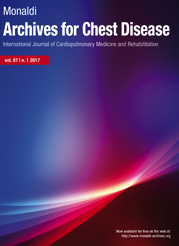Psychological morbidity and quality of life of patients with pulmonary tuberculosis
All claims expressed in this article are solely those of the authors and do not necessarily represent those of their affiliated organizations, or those of the publisher, the editors and the reviewers. Any product that may be evaluated in this article or claim that may be made by its manufacturer is not guaranteed or endorsed by the publisher.
Authors
Tuberculosis (TB) is associated with psychological distress, poor coping, deterioration in health-related quality of life (HRQL), and stigma. However, these issues have never received sufficient attention as a part of routine care. The healthcare workers and physicians of primary contact are not sensitized to use discrete screening questionnaires to identify and address these issues. A longitudinal study was hence conducted in the Department of Pulmonary Medicine in collaboration with the Department of Psychiatry. 75 microbiologically confirmed ‘new’ pulmonary TB patients were enrolled. Socio-demographic and clinical details were noted. The patients were then evaluated for psychological distress using the General Health Questionnaire-12-Hindi version (GHQ-12) and Patient Distress Thermometer (PDT); coping strategies using the Coping Strategy Check List-Hindi Version (CSCL); HRQL using the World Health Organization Quality of Life-Brief-Hindi version (WHOQOL-Bref), and stigma using the Explanatory Model Interview Catalogue-affected persons Stigma Scale (EMIC-SS), at the start of treatment. Those having a GHQ-12 score ≥3 were labeled as ‘screen positive’ for psychological distress and referred to a consultant psychiatrist for detailed psychological assessment. Treatment was given by the psychiatrist if diagnosed with a psychiatric illness. All those without the diagnosis of a psychiatric illness were counseled by a pulmonologist. All patients were called for a follow-up visit and repeat assessments on the 15th day at the end of the intensive phase, using the same instruments employed at baseline. The patients already on treatment by the psychiatrist were again evaluated for their psychiatric illness. 32 (42.7%) patients had psychological distress (GHQ-12≥3) at baseline. 20 of them (26.7%) were diagnosed with a psychiatric illness. However, only 2 (2.7%) patients had psychological distress and psychiatric illness at follow-up (p<0.001). Mean scores of GHQ-12, PDT, CSCL, WHOQOL-Bref-26, and EMIC-SS at baseline were 3.000±1.9590, 2.333±1.2980, 3.480±2.2017, 311.63±30.201 and 5.267±1.8478, respectively. All the scores improved significantly at follow-up (p<0.001). The scores of the various instruments used in the study significantly correlated with each other. Comprehensive screening for psychological distress and assessment of HRQL should be part of routine TB care. The healthcare workers under the program should be sensitized to use the various screening tools on a day-to-day basis to identify patients who require expert psychiatrist care. The majority of the patients with distress, but without a psychiatric illness, can be handled well with dedicated counseling sessions by the healthcare workers themselves. The ancillary staff should be encouraged and trained to meet the demands in resource-constrained settings. A multidisciplinary approach, with close integration of TB programs with mental health services, is urgently required to eliminate TB.
Ethics approval
This study was approved by the institute’s Ethics committee vide letter no. Trg.9(310)2022/24733 dated 27-07-2022.How to Cite

This work is licensed under a Creative Commons Attribution-NonCommercial 4.0 International License.






